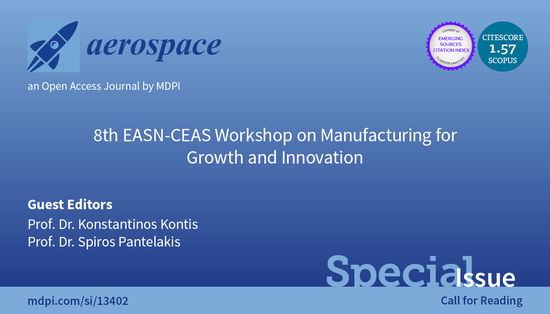This Special Issue contains selected papers from works presented at the 8th EASN–CEAS (European Aeronautics Science Network–Council of European Aerospace Societies) Workshop on Manufacturing for Growth and Innovation, which was held in Glasgow, UK, 4–7 September 2018. About 150 participants contributed to a high-level scientific gathering providing some of the latest research results on the topic, as well as some of the latest relevant technological advancements.
Νine interesting articles, which cover a wide range of topics including characterization, analysis and design, as well as numerical simulation, are contained in this Special Issue. Trompeta et al. [
1] assessed the critical multifunctionality threshold in order to optimize the electrical, thermal and nanomechanical properties of composites enhanced with carbon nanotubes for aerospace applications. The results showed an increased electrical conductivity up to seven orders of magnitude at a critical concentration. An increasing thermal stability was found as the multiwalled carbon nanotubes’ (MWCNTs’) concentration was increasing. Improved nanomechanical properties were exhibited. However, increasing further the MWCNTs’ concentration led to decreased nanomechanical properties. In the paper of Donateo et al. [
2], a methodology to quantify the synergies between power system architecture, energy and the actual battery power was proposed. Two cases were investigated: the case of a fixed-wing-tail-sitter Vertical Take-Off and Landing Unmanned Aerial Vehicle (VTOL-UAV), and a Medium-Altitude Long-Endurance Unmanned Aerial Vehicle (MALE-UAV). The results showed large improvements in the first case regarding the target performances. Sahin and Yaman [
3] studied the synthesis, the analysis and the design of a special type of deployable mechanism, which is the scissor structural mechanism (SSM), for the morphing of the trailing edge of an aircraft wing. The analytical results showed a similar aerodynamic behavior with the desired NACA airfoils. Bergman et al. [
4] developed an innovative scaled model for unmanned aircraft systems (UAS), named e-Genius-Mod. This model will facilitate the testing and assessment of new aviation technologies in a scaled version with an opportunity for free-flight demonstrations in relevant environments. Furthermore, the e-Genius-Mod system may close the gap between upstream research and flight demonstration, aiming at reaching a higher technical readiness level. In the study of Vrchota et al. [
5], the boundary conditions applied to active flow circulation control were verified. The unsteady periodic flow inside the Suction and Oscillatory Blowing (SaOB) actuator was analyzed, using two Computational Fluid Dynamics (CFD) methods of ranging complexity (Unsteady Reynolds Average Navier–Stokes (URANS) and hybrid Reynolds Average Navier–Stokes (RANS)-Large Eddy Simulation (LES)). The simulation was experimentally validated. Although the obtained results are in a very good agreement with the experimental data, some differences still exist. Müller et al. [
6] developed a novel numerical model that integrates the interaction between fluid and structure for modeling emergency landings on water, also referred to as ditching, in full scale. Specifically, this work focuses on the development of a suitable fluid-structure coupling framework and the generation of the structural model of the aircraft. Full-scale structural models for ditching are complex and need to account for damage. This results in severe nonlinearities in the model. Katsiropoulos et al. [
7] have assessed the carbon footprint and the financial viability of different materials and manufacturing scenarios, as well as recycling scenarios, associated with the production of aeronautical structural components. For this purpose, the authors developed Life Cycle Analysis (LCA) and Life Cycle Costing (LCC) models and implemented them for the case of a helicopter’s canopy production. The results showed that the optimal route both in terms of environmental and financial efficiency was the production of the canopy by using carbon fiber reinforced thermosetting composites and involving resin transfer molding (RTM) as the manufacturing process. Torres et al. [
8] described the technological and scientific efforts on designing, manufacturing and testing validation for high-performance low-cost composite structures for Light Sport Aircrafts (LSA). The manufacturing and the assembly of a Light Sport Aircraft were developed by using Computational Fluid Dynamics (CFD), Finite Element Analysis (FEA) and Liquid Composite Manufacturing (LCM). A 15% difference in the performance of the aileron beam as compared to the simulation results was found, which was attributed to manufacturing errors. In the study of Dubovikov et al. [
9], structural and manufacturing schemes for low-curvature pressurized fuselage panels were proposed, facilitating the possibility to provide high-weight efficiency for the airframes of prospective civil blended wing-body (BWB) aircraft. The ability to manufacture double-lattice panels was investigated and a relative model was developed. The results of the weight efficiency analysis of the double-lattice flat panels of a hypothetical BWB aircraft were presented. The results showed significant weight saving by the use of double-lattice panels as compared to the conventional composite analogue.
The editors of this Special Issue would like to thank the authors for their high-quality contributions and for making this Special Issue manageable. Additionally, the editors would like to thank Ms. Linghua Ding and the Aerospace editorial team.





